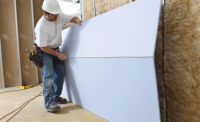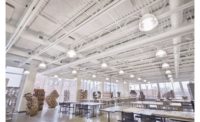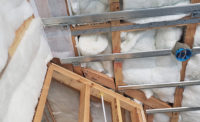When Saint-Gobain Corp. and its subsidiary CertainTeed Corp. set out to build a dynamic, sustainable workplace focused on employee well-being through the use of materials from the Saint-Gobain family of companies, the site selection process came to a halt when they toured a vacant corporate campus in Malvern, Pa.
The 65-acre site featured two existing four-story buildings joined by a four-story connecting link. They were designed by noted Philadelphia architect Vincent Kling for National Liberty Life Insurance in the early 1960s, only a few years before the corporation moved into the three-building complex about nine miles away that the company called home for 45 years. The site had been unoccupied since 2009 while the developer waited for a client with the imagination, and commitment, to realize the property’s full potential.
The company took on the challenge of converting the outdated facility, constructed primarily of glass and exposed steel, into office space that was comfortable for workers, eligible for the highest levels of LEED certification, and designed to function as a “living laboratory” where the performance of its products could be measured and evaluated on an ongoing basis.
Managing Thermal Comfort Sustainably
As one of the world’s largest manufacturers of building materials, Saint-Gobain realized that the location presented an unusual opportunity to use a wide range of building materials from its family of companies, including insulation, wallboard and ceiling systems from its largest construction brand, CertainTeed. One of the biggest design questions was how to optimize thermal management in an open-plan office space encased in walls of glass.
To address this challenge, the corporation’s Sustainable Insulation fiberglass batts were maxed out in spandrel sections at floor lines. Existing brick masonry wall sections housing elevator, stair and mechanical columns, which previously were only insulated with block fill, were incorporated into the new building design and covered with several inches of continuous insulation over the entire surface.
Using Sustainable Insulation as a thermal break between the new curtainwall frame and the existing building structure, as well as maximizing the thermal resistance of opaque wall areas, allows the building to resist heat flow to the greatest extent possible. Furthermore, Sustainable Insulation does not contribute particulates or volatile organic compounds to the interior environment; this helps the project reach its air quality as well as thermal performance goals. It also contributes to better acoustics by helping reduce sound transmission between rooms.
More than Just Walls
As part of its strategy to maximize air quality, the project team employed AirRenew, an innovative CertainTeed drywall product, to help ensure a healthy atmosphere. It’s one of several types of CertainTeed drywall used in the new headquarters complex that satisfy specific performance requirements including moisture, mold and impact resistance, sound dampening, acoustic enhancement—and even air cleaning.
The air in the complex is already much cleaner than is typically found in an office environment. CertainTeed’s Stan Gatland, manager, Building Sciences and Comfort, notes that the use of low-emitting and no-emitting materials and a robust air exchange system has resulted in very low levels of carbon monoxide, particulates and VOCs.
To further reduce the presence of unwanted atmospheric “guests,” AirRenew Essential drywall was utilized throughout much of the complex. AirRenew employs industry-first technology that actively removes formaldehyde from the air and converts it to a safe, inert compound.
“The air in the buildings is so clean that some employees wondered if we were pumping in pure oxygen,” says Gatland.
Since the exterior walls on the first floor of the building are either partially or completely below grade, AirRenew M2Tech moisture and mold resistant drywall was specified. M2Tech technology further improves indoor air quality by providing enhanced mold and moisture resistance.
These specification decisions, in concert with low-emitting materials such as Sustainable Insulation and “green housekeeping” practices, are helping the Malvern facility ensure optimum indoor air quality for all employees – and enabled the building to achieve LEED Platinum status (the highest level of certification) for the commercial interior as well as the core and shell.
Sound Decisions
One of the project’s biggest challenges was acoustics. Both wall and ceiling systems were designed to minimize sound transmission in open areas.
In addition to the insulation’s sound controlling properties, the company’s acoustical experts also devised a two-part ceiling solution that offers excellent sound absorption: Ecophon Symphony F fiberglass ceiling panels and Adagio mineral/fiberglass hybrid ceiling panels. For surrounding huddle rooms and smaller meeting rooms, Symphony M mineral ceiling panels were selected. All three products feature the same smooth, contemporary finish for a consistent visual look.
To manage sound in the towering main entryway, Decoustics Claro custom ceiling panels, installed with a Ceilencio ceiling suspension system, are paired with the company’s custom wood wall panels. Claro Ceilencio horizontal fiberglass ceiling panels feature a curved shape that mimics the contours of the building’s exterior façade.
Balancing aesthetics and performance was part of the process. According to Bob Marshall, senior manager, Technical Services, for CertainTeed Ceilings, “Occasionally, the desire to showcase certain products was trumped by the need for specific acoustic performance. The opposite also occurred. In the end, it’s great to be able to evaluate an actual built environment and see how it aligns with the theoretical foundations of our product line.”
Another unique element of the project was the large number of different ceiling products specified throughout the facility. Marshall explains, “The contractors were surprised at all the different products we were having installed in the same space. They didn’t understand the benefits, and wondered why we couldn’t just use one or two panel types.”
But Saint-Gobain and CertainTeed were intent on maximizing acoustic performance in the new facility. “Education is key,” Marshall continues, “Once the contractors saw the difference using the various tiles made in the acoustics of the space, they totally got it.”
Wall systems were also chosen with an ear toward acoustic performance. On the upper floors, area separation walls that surround meeting spaces feature SilentFX noise reducing drywall, which sandwiches a viscoelastic polymer between two dense gypsum cores, reducing sound transmission by as much as 75 percent when the board is used on both sides of the wall assembly, as was done in Malvern.
Measuring Real-world Performance
Saint-Gobain’s new headquarters is more than just a showcase for innovative design; it’s also an opportunity to test and evaluate the performance of its products in an actual work environment.
Led by its team of building scientists, Saint-Gobain is partnering with Dr. Ihab Elzeyadi of the University of Oregon to assess the impact of the building’s design on the occupant experience, measuring factors such as indoor air quality and thermal, acoustical and visual comfort.
“Our goal is to take measurements, gauge employees’ experience and comfort levels, and then adjust the building accordingly to make it a better environment,” says Stan Gatland. Once the Malvern complex reaches its one-year anniversary in October 2016, a full, four-season data set will be available and the company will begin to share the results of its efforts to assess performance. Saint-Gobain plans to have complete results by early 2017, Gatland says.
“It really is a living, learning laboratory,” says Marshall. “If something doesn’t work, we can go back and change it based on the occupant experience.”
PROJECT TEAM
The E. Kahn Development Corp. and J. Loew & Associates, Inc., in collaboration with the AEGON USA Realty Advisors LLC, led the headquarters redesign project. The design team included Bernardon (core and shell architect); Jacobs (interior designer); and D. Fickler Construction LLC (general contractor). Additional support was provided by local sustainability consulting firms including The Sheward Partnership, Jacobs and Sustainable Solutions Corp.















Report Abusive Comment